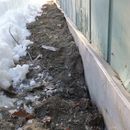Frost heaving of exterior foundation insulation
We have frost heaving pushing up our new exterior foundation insulation, and bending the Z flashing that sits on top of it to slope toward the house (see attached photo). Has anyone else experienced this and/or have suggestions for ways to correct the problem?
More complete story:
We are halfway through a Pretty Good Retrofit of a 1970 raised ranch in zone 6A, central NH. The work in the fall included excavating to replace a no-longer-functional footing drain system and adding 2″ of exterior insulation to the 4′ stem wall. We used 3′ of EPS with a 1′ strip of mineral wool on the top, based on the theory that that would better allow the concrete to dry to the outside. The mineral wool is covered with stucco, and a Z-flashing is placed over the top. In the spring/summer we plan to add 2″ exterior EPS insulation over the old T111 siding/sheathing and then new clapboard siding over the insulation.
There are reasons to believe that this year was a perfect storm of conditions to make this happen. In addition to the very cold winter, the following factors probably contributed:
1) Due to some scheduling problems with the excavator, the trench sat open until very late in the fall, allowing the deeper soil to get very cold and even freeze a bit, and the back filling was done with similarly cold soil.
2) The fall was very wet. Some of the backfilling was done with sopping wet clay soil sludge, and it didn’t have time to dry before it started to freeze.
3) The excavator didn’t do a good job with the grading, which doesn’t slope away from the house much in some areas, including most of the spots that have this problem.
Our thoughts about what to do include:
- Simply trimming the top of the insulation off to allow the Z flashing to bend down and slope a bit away from the house, perhaps after things thaw.
- Correcting the grading if and when spring arrives,
- Perhaps a gutter on this side of the house (the south side, where sun can help keep a dark-colored gutter flowing in March).
Is this likely to be enough? Is this a common problem?
GBA Detail Library
A collection of one thousand construction details organized by climate and house part










Replies
Charlie,
Experts advise that foundation holes be backfilled with free-draining material like crushed stone or gravel, topped by a thin layer of soil. It sounds like you didn't do this.
The best remedy -- not the cheapest -- is to excavate down to the bottom of the rigid foam, remove the clay soil, and backfill with clean, free-draining material. If the material (soil or gravel) near your foundation is dry, it won't heave.
Thanks Martin. I was afraid that would be recommended. It all comes from selecting the lowest bidder on the excavation work. (That was hardly on the only part of the job he did badly.)
It's worth considering wing insulation as recommended for a Frost Protected Shallow Foundation (FPSF) It has the advantages of not having to excavate, and it further reduces heat loss from the building.
I'd post the link, but the spam filter keeps blocking me.
Thanks Kevin. That's a good idea. It would become a FPCB (frost protected clay backfill).
No need to post the link--I'm familiar with that approach.
In case any other GBA readers want the link, here it is:
Frost-Protected Shallow Foundations.